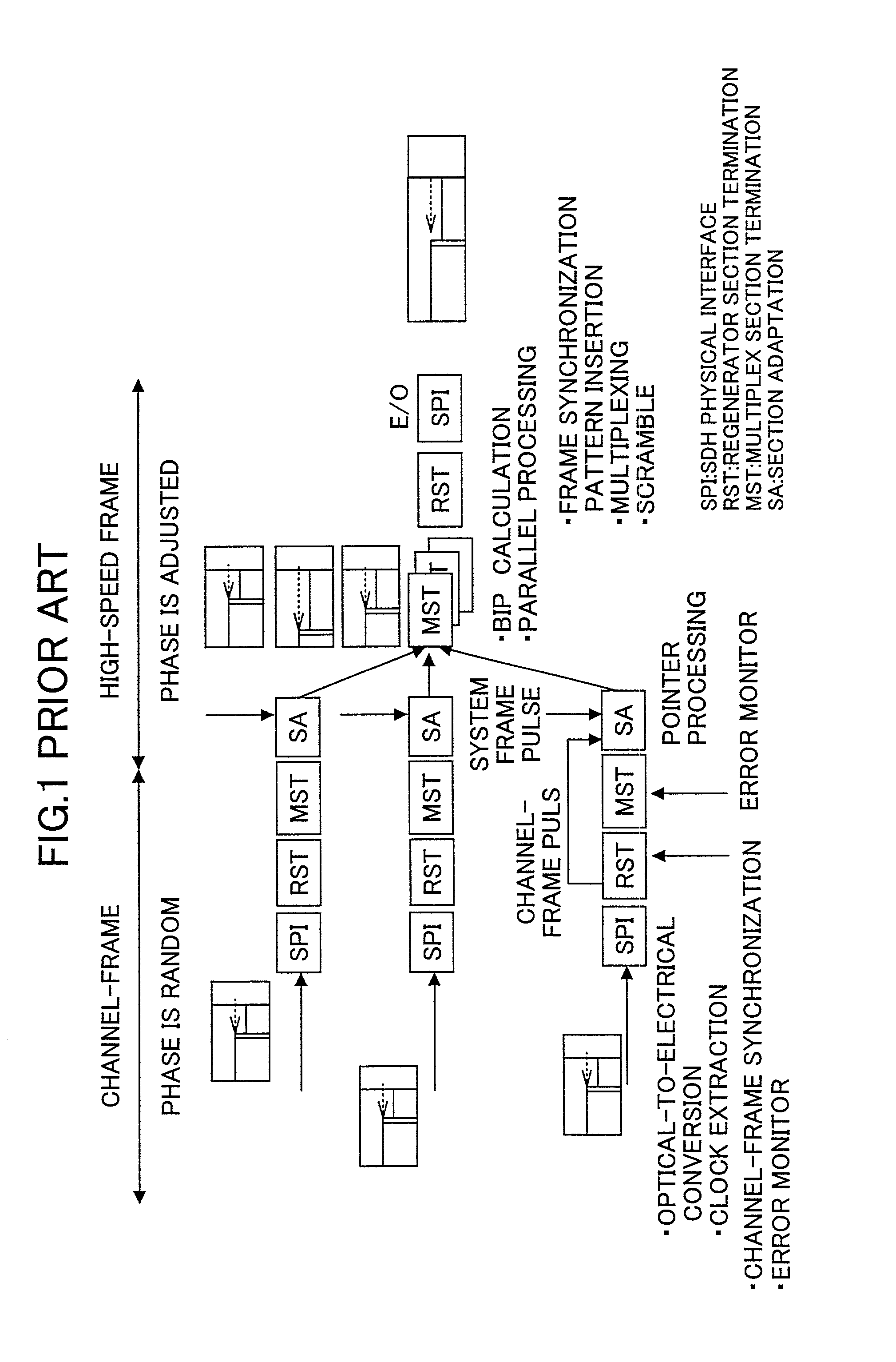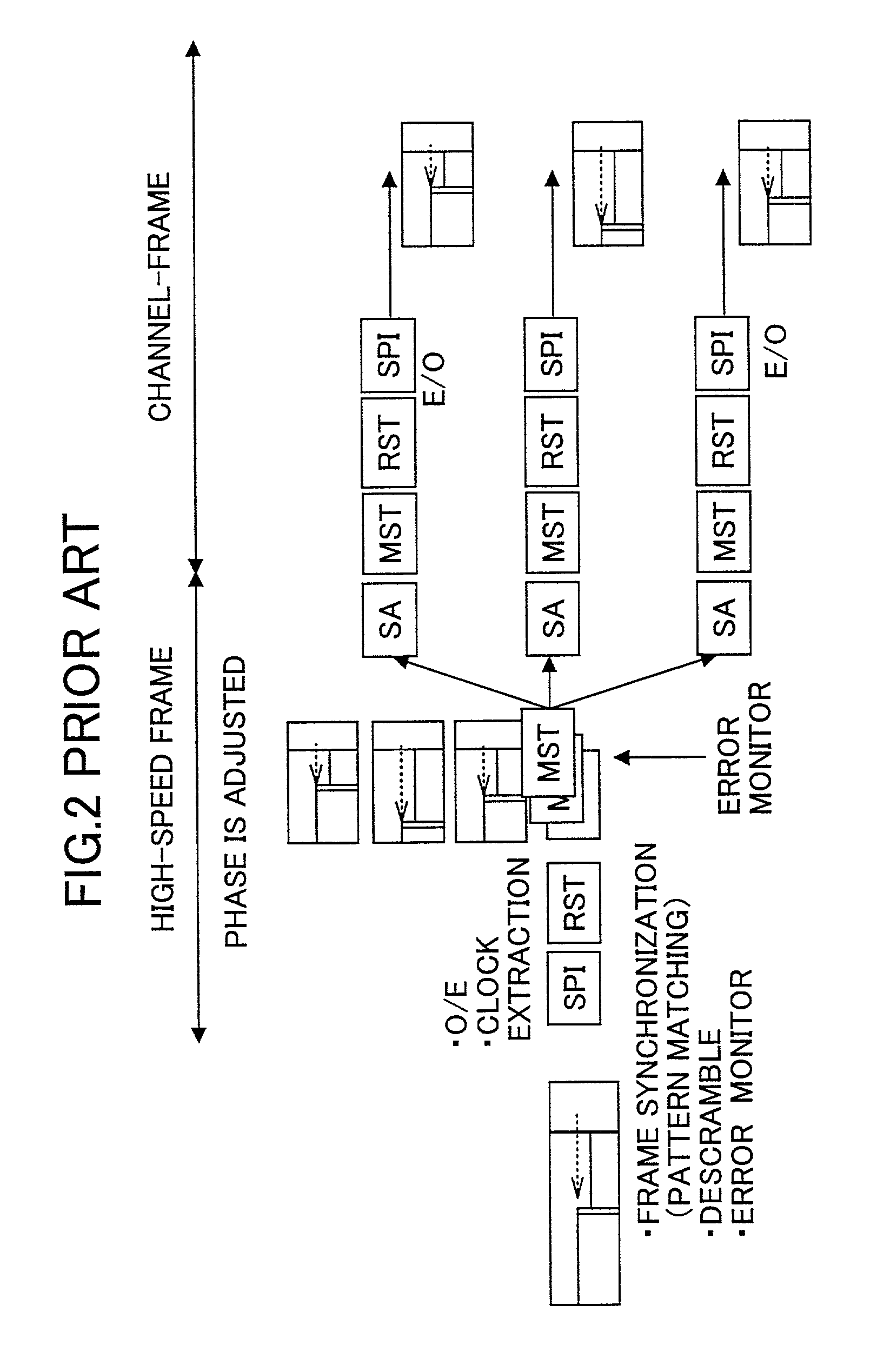Multiplexing and transmission apparatus
a transmission apparatus and multi-channel technology, applied in the field of multi-channel transmission apparatus, can solve the problems of complex and large-scale circuits, difficult to achieve frame synchronization processing in 10 gbit/s systems, and complicate the realization of intelligent processing operations. , to achieve the effect of reducing complexity and development cos
- Summary
- Abstract
- Description
- Claims
- Application Information
AI Technical Summary
Benefits of technology
Problems solved by technology
Method used
Image
Examples
embodiment 1
[0058]Embodiment 1 is explained using FIG. 3A to FIG. 15C. FIG. 3A shows a block diagram of a transmitter 100 and FIG. 3B shows a receiver 200 of the present invention. FIG. 4 shows the operation of the transmitter and FIG. 5 shows the operation of the receiver. FIGS. 6A and 6B are for explaining how the channel number is identified in the receiver. FIG. 7 shows a block diagram of a control pulses generating circuit 30. FIG. 8 shows an example of a time-chart of control pulse in each channel. FIG. 9 shows a block diagram representing a channel-frame generation circuit 10. FIG. 10 shows a block diagram of a multiplexing circuit 20. FIG. 11 shows a block diagram of a demultiplexing circuit 50. FIG. 12 shows a block diagram of a channel-frame synchronization circuit 60. FIG. 13 shows a configuration example of a switching circuit 70. FIG. 14 shows a block diagram of a switch controller circuit 90. FIGS. 15A–15C provide an example of the operation of the switch controller circuit 90.
[00...
embodiment 2
[0092]An embodiment 2 in the present invention is described using FIGS. 16 to 18. FIG. 16 shows a block diagram of the channel-frame generating circuit 10. FIG. 17 illustrates phases of channel-frames generated by the channel-frame generating circuits 10. FIG. 18 shows a block diagram of the channel-frame synchronization circuit 60 and the channel-frame termination circuit 80.
[0093]The embodiment 2 is modified from the embodiment 1 with respect to the channel-frame as FEC sub-frame as specified in ITU-T G.975. The channel-frame generating circuit 10 in the transmitter 100, and the channel-frame synchronization circuit 60 and the channel-frame termination circuit 80 in the receiver 200 differ from those in the embodiment 1. Hereafter, only the differences from the embodiment 1 are described; identical parts are omitted from this description of embodiment 2.
[0094]As shown in FIG. 16, the channel-L-frame generating circuit 10 includes an O / E (optical-to-electrical conversion) circuit 4...
embodiment 3
[0100]The embodiment 3 is explained using FIGS. 19 and 20. The present invention is advantageous in terms of fast processing, because the frame pulses of the channel-frame synchronization circuit 60 in the receiver directly activate the switching circuit 70 by hardware logic. Note that the present invention also allows the use of software / firmware to implement the switch controller circuit 90.
[0101]FIG. 19 shows a hardware configuration example, where the switch controller circuit 90 is realized using computer software. FIG. 20 shows a flow-chart of this example. The embodiment 3 is explained in detail hereafter focusing only on the points different from those of the other embodiments.
[0102]In FIG. 19, the switch controller circuit 90 of this embodiment employs a personal computer (PC) 301, an interface for the PC 302, a memory 303, buffers 304, and an interface 305 to the switching circuit 70.
[0103]Frame pulses from the channel-frame synchronization circuit 60 are recorded in the m...
PUM
 Login to View More
Login to View More Abstract
Description
Claims
Application Information
 Login to View More
Login to View More - R&D
- Intellectual Property
- Life Sciences
- Materials
- Tech Scout
- Unparalleled Data Quality
- Higher Quality Content
- 60% Fewer Hallucinations
Browse by: Latest US Patents, China's latest patents, Technical Efficacy Thesaurus, Application Domain, Technology Topic, Popular Technical Reports.
© 2025 PatSnap. All rights reserved.Legal|Privacy policy|Modern Slavery Act Transparency Statement|Sitemap|About US| Contact US: help@patsnap.com



